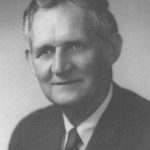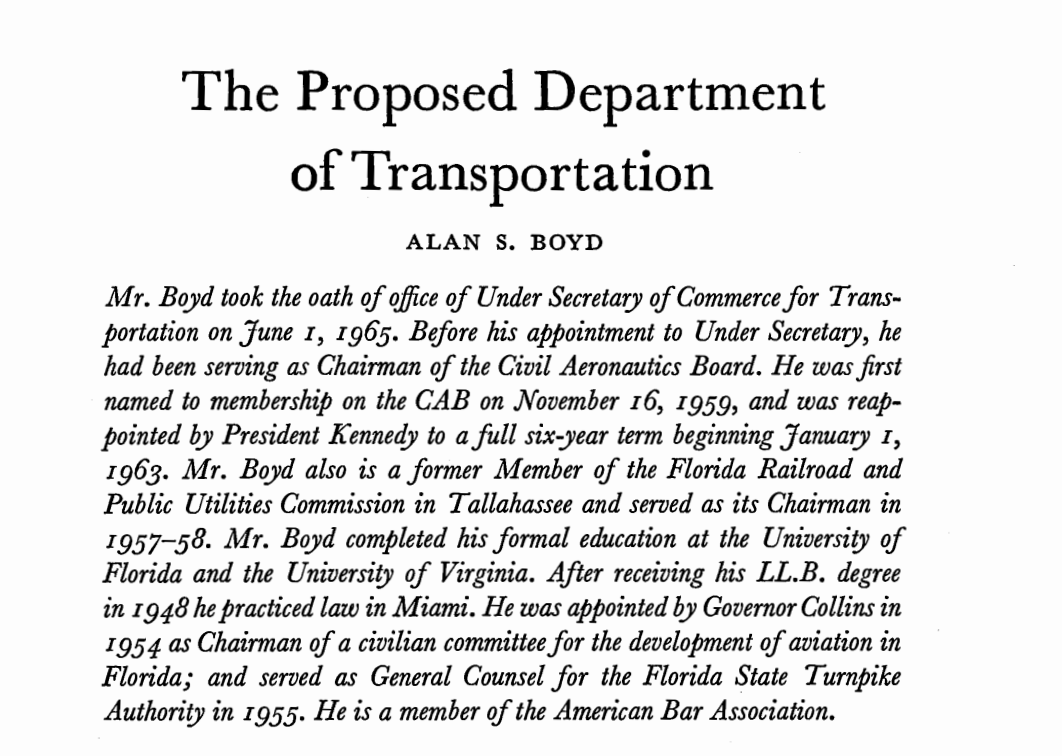In the 1960’s!
In 1968, the bylaws were amended to change the name from Eno Foundation for Highway Traffic Control to Eno Foundation for Transportation, thereby identifying the Foundation’s expanded scope of interest in transportation. Under the chairmanship of Wilbur Smith, beginning in 1965, Eno Foundation publications emphasized such subjects as the national problem of traffic safety, roadside hazards, speed enforcement policies and practices, zoning, and traffic-reexamining problems that were covered in earlier years. Some key moments for the industry included the creation of the U.S. Department of Transportation (USDOT), the appointment of Alan Boyd as the first Secretary of Transportation, and the passage of the Urban Mass Transportation Act into law on July 9, 1964.
The Founding of USDOT
The Creation of USDOT
The Creation of USDOT

On Saturday, October 15, 1966, President Lyndon Johnson signed into law the bill that created a new U.S. Department of Transportation. The enactment of the law was the culmination of a lengthy process of policy development and legislative action, all of which is chronicled on Eno’s now-complete Documentary History of the Creation of the U.S. Department of Transportation webpage. The Department of Transportation Act became Public Law 89-670. Johnson would announce on November 6 that Alan Boyd would indeed become the first Secretary of Transportation. The new Department would begin operations on April 1, 1967.
A Conversation with Alan Boyd
A Conversation with Alan Boyd

Alan S. Boyd was the first Secretary of Transportation, sworn in on January 26, 1967. But he also served as Under Secretary of Commerce for Transportation from 1965 to 1967, and in that capacity, he was the Johnson Administration’s chief public advocate of the creation of a new USDOT. Prior to Commerce, he had served as chairman of the Civil Aeronautics Board. Boyd passed on Sunday, October 18, 2020, leaving behind a transportation policy legacy.
Then
Short Run Congestion Cost and Pricing
“[It] would appear that the use of short-run, quasi-marginal cost pricing and thus congestion tolls for those facilities and situations where demand and congestion are high and where travel time savings are highly valued, would not necessarily result in ‘more efficient use’ of the limited facilities. In fact, using many economic criteria, use of congestion tolls would appear to produce a less satisfactory or less efficient situation than were average cost pricing be continued as a matter of policy.”
The Short Run Congestion Cost and Pricing by Martin Wohl, published in Transportation Quarterly
Now
Congestion Pricing in the United States
“There is no silver bullet to fix the woes of urban mobility and access, but congestion pricing is a proven, viable, and effective tool. Charging a fee for the parts of the roadway network used the most during the busiest times of day reduces demand. The charges incentivize travelers to switch to other modes of transportation, seek alternative routes, or travel at other times. The charges can help to reduce negative effects of traffic such as air pollution, carbon emissions, road damage, and traffic crashes.”
Congestion Pricing in the United States: Principles for Developing a Viable Program to Advance Sustainability and Equity Goals by Brianne Eby, Martha Roskowski, and Robert Puentes, published by the Eno Center for Transportation
Traffic Quarterly Spotlight
“The private car of today appears to have little future in the world of tomorrow.”
Much has changed in 50 years, but it’s also instructive to review the predictions for the future to evaluate how the transportation profession has addressed, or not addressed, the challenges of the past. Traffic Quarterly articles from the 1960s demonstrate a remarkable semblance of today’s challenges, and today’s proposed solutions. Take, for example, “Better Roads Mean Better Living – But,” a 1968 article by Victor Azam. He states that “the very success of the [automobile] carries with it the seeds of its own destruction,” continuing to address how roadway expansion creates ever-increasing congestion that we cannot build ourselves out of.
However, he boldly states that “the private car of today appears to have little future in the world of tomorrow.” To solve the transportation woes of the 1960s, he discusses how electric cars have been “developed by several manufacturers.” London is experimenting with deploying “automatic taxi trains.” The federal government is developing a “new vehicle” for American cities, involving “small vehicle door-to-door pickup feeding larger trunk-line vehicles.” The clairvoyant Azam even predicts Elon Musk’s Boring Company, with freight traveling on “rail-mounted electrical ‘sleighs.’” In fact, he closes his article by supporting the notion that roadways could very well be built on the moon within 20 years.
Written by Paul Lewis, Vice President of Policy and Finance at Eno
“The automobile is here to stay.”
The futuristic view of transportation in TQ in the 1960s also shines through in the opening of Russell E. Singer’s 1964 article “Future Role of the Automobile in Urban Transportation.” His vision of automated transit and micro mobility in a fully V2X connected urban landscape included monorails (with enough seats for everyone!), moving sidewalks, personal flying devices, and notably, a high-speed elevator.
Singer takes the opposite opinion from Victor Azam, insisting that “The automobile is here to stay.” He saw the rising populations in suburbs and multi-nucleic urban growth patterns as an obvious reasons why personal automobiles will continue to play a role in U.S. transportation, and pointed to user preference surveys showing that most people just prefer traveling in private automobiles. When thinking about modal and technology shifts moving forward in the twenty-first century, these factors still ring true. Our land use is not built up to support high-frequency, full coverage mass transit outside of urban areas, and some people will never prefer to use shared fleet or shared vehicle transportation options. 50 years later, transportation planners and policy-makers are still trying to find the right balance in multimodal infrastructure spending and urban planning practices.
Written by Alice Grossman, PhD, Former Senior Policy Analyst at Eno
Did you know?
President Lyndon Johnson signed the Urban Mass Transportation Act into law on July 9, 1964. The new measure provided $375 million in capital assistance over three years. It passed the House by a vote of 212-to-129 and cleared the Senate 52-41.
“We are a nation of travelers. You cannot write our history without devoting many chapters to the pony express, the stagecoach, the railroad, the automobile, the airplane…Yet, until 1964, the Federal Government did little or nothing to help the urban commuter,’ said President Lyndon B. Johnson, on Remarks at the Signing of the Urban Mass Transportation Act.”



